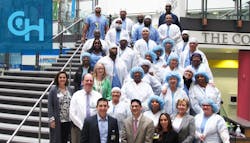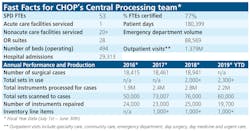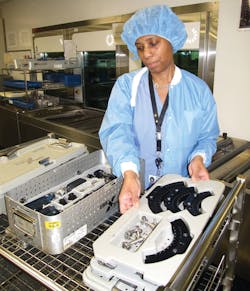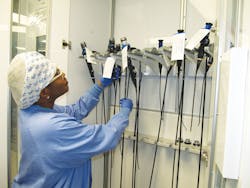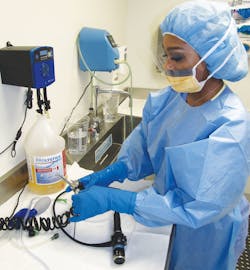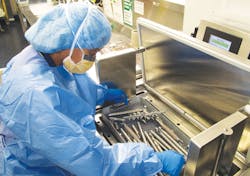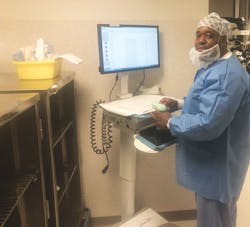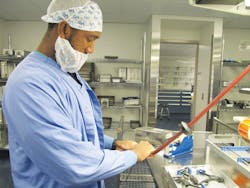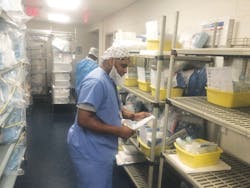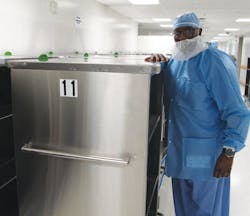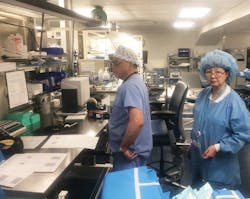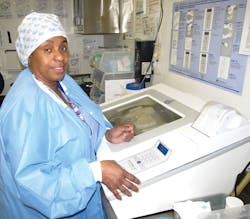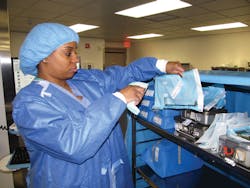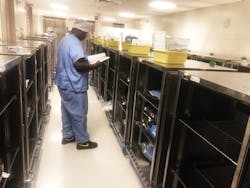CHOP CPD team makes service central to clinical core competencies
Nineteenth century educational writer William Edward Hickson may be credited for promoting the proverb, “…if at first you don’t succeed, try, try, try again,” more than 160 years ago, but Children’s Hospital of Philadelphia, launched around the same time, saw its Central Processing Department put that proverb into practice more than 160 years later.
CHOP’s CPD team, along with Perioperative Services and Supply Chain, understood the proverb’s value well enough. And in a bit of overachievement, the CPD team busted up another popular expressive phrase: No, the second time actually is the charm.
Unlike many Sterile Processing and Distribution departments around the nation today, CHOP’s CPD reports to Supply Chain and not Perioperative Services. As far back as the early 1990s, Healthcare Purchasing News started recording an operational migration via its annual readership surveys that showed a growing number of SPD departments were reporting to the Operating Room or Surgical Services, typically part of Perioperative Services, rather than to Supply Chain, which included Materials Management. Back then, CPD was no exception to that shift.
Two years ago, however, CHOP formally bucked the trend, reversing course to return CPD to Supply Chain from Perioperative Services. Several key reasons motivated the decision: The organization was centralizing operations — including CPD — across its expanding campus and outlying facilities amid higher patient and procedural volumes; they wanted to improve product fulfillment for Perioperative Services throughout the enterprise; and they sought deeper access to a data vein as the organization automated operations and processes via an integrated enterprise resource planning (ERP) system, an electronic health record (EHR) system and other clinical systems and software.
Anticipating some challenge with the transition, Supply Chain sagely recruited a surgeon who promoted CPD’s redesign and paved the way to the next level of customer service they would provide to Perioperative Services.
“I am proud to say that our partnership with Periop is as strong as ever,” said Robert Silverstein, Senior Director, CPD and High-Level Disinfection Services. “Our leadership teams have a great relationship and that trickles down to our staffs. At the end of the day, we all know our purpose, and it is to ensure that the children we are providing care to, and their families and loved ones, have a phenomenal experience when they come to CHOP. If you keep that at the forefront, especially as a support service, the clinical teams will support you and will know they can rely on your team.”
Silverstein minces few words about the underpinnings of a successful department.
“To me, it is all about accountability,” Silverstein continued. “As a leader, you must understand where your team needs support. You learn that through feedback from your key stakeholders, but more importantly, from your own staff. It is extremely hard to drive change if you do not focus on your team’s accountability first. Like with any line of work, you cannot resolve issues without understanding the root of your problems. For me, that meant rolling my sleeves up and getting into the thick of it with my staff. Seeing the work through their eyes allowed me to understand daily challenges, as well as opportunities for coaching and training. Another key element was setting expectations with our customers; they have a stake in this as well. It is very important for everyone to be on the same page and to have clearly defined channels of communication.”
Based on their aims, accomplishments and attitude, HPN chose Children’s Hospital of Philadelphia’s CPD team as the 2019 SPD Department of the Year.
Children’s Hospital of Philadelphia Sterile Processing Associates
Joni Rittler,
Vice President, Supply Chain
Robert Silverstein, MHA, Senior
Director, CPD & HLDS
Bartholomew Lewis, CHL, CRCST, Technical
Manager
Jill Manuola, MSN, RN-BC, HLDS Program Manager
Lila
Price, CHL, CRCST, Education Coordinator
Marsha Wiilliams, CRCST,
Instrument Specialist
Hai Bui, CRCST, Lead Technician
Daniel
Greenwood, CRCST, Lead Technician
Florencio Miranda, CRCST, Lead
Technician
Jared Crawford, CRCST, Supervisor
Franklin Lindsay,
CRCST, Supervisor
Vencina Newsome, CRCST, Supervisor
Janet
Fisher, CRCST, Cardiac Core Coordinator
Donna Green, CRCST, Cardiac
Core Coordinator
Moneisha Robinson, CRCST, Cardiac Core Coordinator
Tina Barkley, CRCST, OR Core Coordinator
Keena Coleman, CRCST, OR
Core Coordinator
Patricia Harris, CRCST, OR Core Coordinator
Faith Jackson, CRCST, OR Core Coordinator
Darren Baker, Technician
Donna Barbour, CRCST, Technician
Darlynn Coleman-Allen, CRCST,
Technician
Erica Collier, CRCST, Technician
Kristen Collins,
Technician
Florah Dawa, CRCST, Technician
Sheena Freeman,
Technician
Michelle Fulton, CRCST, Technician
Lisa Hamilton, CRCST, Technician
Duryea Hand, CRCST, Technician
Sharnee Hayes, CRCST, Technician
Brandon Henderson, CRCST,
Technician
Charles Hightower, Technician
Ballan Jarret, CSPDT,
Technician
Samia Jones, Technician
Jackie Jones, CRCST,
Technician
Amanata Kamara, CRCST, Technician
Genevieve Koller,
CRCST, Technician
Bei Li, CRCST, Technician
Daxton Lowery,
CRCST, Technician
Brook Maxwell, Technician
Danielle Melloy,
CRCST, Technician
David Moore, Technician
Savannah Pompey,
CRCST, Technician
Tomika Pratt, CRCST, Technician
Robbie
Ridgeway, CRCST, Technician
Lateefa Russell, Technician
Unique
Scott, Technician
Veronica Segars, Technician
Dannie Smith,
CRCST, Technician
Leroy Taylor, CRCST, Technician
Darius Vernon,
CRCST, Technician
Jalisa Voss, Technician
Terrence Wilson,
Technician
Not so rocky road
“Beginning in 2012, Supply Chain made a commitment to Perioperative Services to improve overall operations,” Schemm recalled. “Progressive rounds to identify process improvement opportunities were implemented, including conversations around how we could optimize all of the supply locations, relocate the case cart picking area, and install a kanban system for replenishment. The partnership culminated when we integrated a Supply Chain solution during the Epic OpTime [operating room management system] rollout. This integrated the item master from [Infor’s] Lawson [supply chain module] directly into Epic OpTime, automating patient charging and improving preference card data. The OR leadership recognized our efforts and noted marked improvement in the availability of supplies on the shelves.”
CHOP executives recognized that organizational expansion was starting to outpace the OR’s and CPD’s capabilities to meet demand and knew more operational improvements were needed.
“To support the transition and assure connection to clinical care, I requested that we have a surgeon, Peter Mattei, M.D., work with us as a sponsor throughout the transition,” Rittler said. “Dr. Mattei visited CPD and was impressed with the volume of work that the team handled. His simple expression of gratitude for making his job easier meant the world to the CPD team! He also championed the change with the OR Steering Committee to gain support from clinical leaders.”
Go rounds
CPD used a structured approach to consolidating reprocessing staff and equipment, according to Cheryl Gebeline-Myers, Senior Director, Clinical Operations and Programs. They also worked with Infection Prevention and Control to solidify a training program that focused on safety and efficacy, as well as developed a comprehensive, data-driven approach to quality and performance measurement and improvement that included easily accessible standardized policies and procedures. The group also evaluated and implemented technology for scope storage, transport and tracking, Gebeline-Myers noted, and standardized HLD/S-related equipment and tools as necessary.
CPD, Supply Chain and Perioperative Services have realized marked improvement already.
“Like many organizations who have grown substantially in a quick period of time, we had departments that were high-level disinfecting/sterilizing their own items,” Manuola noted. “Each individual site was responsible for maintaining competency dates for their own staff. This made it extremely difficult to plan education because, at any given month, there were multiple staff members due for re-validation of their competencies throughout the enterprise. Our previous process was not standardized or timely.
“We chose to hold an in-person session annually so that HLD/S Qualified Observers throughout the entire CHOP enterprise could join together and learn from each other,” Manuola said. “We also used this time to kick off the new Competency Process and ensure that all the qualified observers have the tools and resources they need to re-validate staff on their competencies. Since these competencies are reviewed annually, it made sense to run the training annually.
CPD also encourages staffers to learn more about their customers directly and vice versa, Silverstein noted.
“We do provide opportunities for CPD staff to round with our customers to learn how their work plays such an instrumental role in the caregiving process,” he said. “In addition, CPD routinely opens its doors for nurses, clinicians, etc. to tour our department so they have some insight into our world and understand our processes/procedures. During our HLD/S Qualified Observer training, we did offer tours of our CPD department for those working at other locations. We also allowed time for staff to network with each other and discuss best practices. Our first session focused more on back to the basics — Infection Prevention and Personal Protective Equipment — but we are looking to include more detail [and] hands-on experiences moving forward.”
Periop partnerships
Silverstein defines OR Success as “how the team performed in the eyes of the nursing staff from the previous day’s cases,” or more tactically as “a surgical procedure with no issues filed.” CPD tracks this figure via an electronic survey nurses complete after every case that asks about missing instruments or supplies, bioburdens, hair, etc. CPD set its goal at a minimum of 88 percent after initially achieving 70 percent; it exceeded and has sustained an average of 91 percent since fiscal year 2018.
Fielded Instruments represents a measurement of the amount of completed instrumentation in CPD’s tracking system, which is Microsystems’ SPM. Instruments qualify by having completed the sterilization process and assigned to a storage location. CPD tracks all sets not located within a CPD processing area, including decontamination, assembly, sterilization, cooling or missing, according to Silverstein. CPD set its goal at 82 percent after initially recording 64 percent; the team met its goal in fiscal 2018.
CPD originally set 85 percent as a possible target rating, accounting for sets that could be broken, instruments could be loaned out to other areas or missing, Silverstein indicated. “Progressive improvement of the data and operations allowed us to see major improvements, but 100 percent is not realistic,” he admitted. “The key goal was to demonstrate that CPD could make as many sets as possible available for the next day. Things like emergency overnight cases would cause challenges.”
Notably, convincing OR nurses to complete an electronic survey after every case drew support from a joint team of surgeons, nursing staff, anesthesia, CPD and process improvement specialists because the group recognized that they had to measure something before improvement could be quantified and tackled, according to Schemm. The initial response was 35 percent, but after four months it jumped to 85 percent and higher. “A key enabler was the fact that the survey process and the case schedule allowed the team to identify the surgeons and nurses who were not completing the surveys, and the nurses did an effective job of self-enforcing the process,” Schemm said. “We are currently looking into capturing this data in a more efficient way for the nursing staff, perhaps within a tool they use every case so we aren’t asking them to use separate software.”
Last fall, in collaboration with performance improvement advisors, CPD identified an opportunity to improve point-of-use instrument spraying. The product utilized at the time was “clear, difficult to use, and not easily visible on the instruments,” Silverstein noted.
“We quickly formed a sub-group with members from CPD and OR,” Silverstein said. “Different products were brought in and were tested by OR staff. These products were ranked according to visibility and ease of use. Based on the results, the new product was selected with collaboration between CPD and OR leadership. The product was first introduced to the OR, then launched throughout the enterprise. This change allowed for a more effective way of identifying whether the instruments had point-of-use spraying. Continued education and training on point-of-use instrument spraying continues to be a key component of our program today. We value the importance of the initial point-of-use spraying as it contributes to the overall sterilization process and helps maintain the integrity of our instrumentation.”
Perched atop CPD
Silverstein stresses the importance of CPD’s customer service as an instrumental contribution to patient care based on their performance.
“Our work really impacts on-time starts and delays, causing cases to go longer than expected,” he said. “It is very rare that we see issues related to these items due to something related to CPD.”
Executive leadership recognizes CPD’s value as well, according to Silverstein, to the point that CPD is now considered a strategic partner with all clinical teams throughout the organization.
“While in the past, the department was usually brought in after decisions had been made, we now sit at the table and help make the decisions that drive patient care,” he said. “We have data at our fingertips, open channels of communication, embedded lean thinking in how we approach our work, and a commitment to training and education to ensure we are placing our staff in positions to succeed. This is not accomplished without a dedicated team of front-line personnel who believe in CHOP’s mission. The individuals who truly make all of this happen are our staff. They understand this is a journey — one that requires patience, trust, and a commitment to something greater than ourselves.
“At CHOP we begin everyday with one goal, making breakthroughs for children,” Silverstein continued. “This is not possible without supporting departments like ours. What is unique about CHOP is that we really are a village. We all know we play a key role in patient care, and the clinical teams know how important our support services are to their success. I think historically many individuals did not have a true appreciation for everything our CPD did or was responsible for. They were also not privy to some of the barriers and challenges we face every day. Establishing clear channels of communication and sitting at the table as a partner you can trust goes a long way. I have never felt a need to convince someone that we are a strategic partner. You illustrate that by performing at a level that does not leave opportunities for concern or questions. That is how we approach our work and how we have been successful.”
There’s more:
Award-winning CPD posits, reflects bright outlook
CHOP’s CPD performance linked to tech
Honorable Mention: Packard Children’s makes SPD matter by reinventing itself
About the Author
Rick Dana Barlow
Senior Editor
Rick Dana Barlow is Senior Editor for Healthcare Purchasing News, an Endeavor Business Media publication. He can be reached at [email protected].
